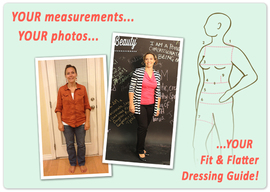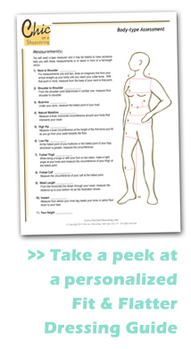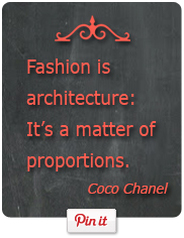A Practical Approach to a Functional Wardrobe In the past 15 years I've worked with 1,000's of women, sizes 0 - 26, and performed numerous Wardrobe and Closet Inventories. >> more info...
In my experience, most women only wear 20 - 30% of the clothing in their closet, which means a lot of wasted money and unnecessary frustration. My end goal with every client is to help find her personal best, develop a functional wardrobe and to look at herself and her body in a more positive light. To accomplish this I follow these four steps: 1) Assess her body. 2) Inventory her closet. 3) Determine her wardrobe needs. 4) Then go shopping. Most women skip steps one, two and three, and then wonder why they have so many "regrets hanging in their closet." |
|
ASSESS YOUR BODY: I analyze the client's body to identify her figure assets and the "challenge" areas, and then I teach her which clothing will flatter her unique body. This is always my first step.
>> Click to see a sample body assessment. My Fit & Flatter Dressing Guide body assessment goes much deeper than, "You're a pear or a triangle," I take into account whether a woman is long or short-waisted, hip to waistline ratio, leg length, natural waistline versus the dressing waistline, and their phase in life (post-menopause, post-baby), etc. I provide an objective body assessment, whereas most women have a distorted self-perception, which makes it very difficult to properly fit their bodies. Over the years I have worked one-on-one with women size 0 – 26, 4'10" to 6'4" and of every shape and proportion, and the fact is, very few women, myself included, have a perfectly proportioned body. Two women can be the same height and the same weight, and even wear the same size, but have very different bodies, which means a pair of jeans or swim suit that looks great on one woman can be quite unflattering on the other. You already buy the jeans, swim suits and other pieces, make a small investment in yourself with a Fit & Flatter Dressing Guide personalized to your photos and your measurements and learn what is most flattering on your body! Also part of this process is changing a woman's mindset so she is not as critical about her own body. When I meet with clients I always ask them what they like best about their bodies. Most women quickly rattle off all the things they don't like and what they're going to do to change, but find it very difficult to be positive and recognize their own figure assets. >> online questionnaire... I try to get women to focus on these positive aspects of their bodies, instead of the negative. I encourage them to accept themselves as beautiful as they are right now and to celebrate their lives, flaunt their curves and differences and to believe in their beauty. >> learn more... You may notice on the Fit & Flatter Dressing Guide questionnaire that it never asks a woman for her weight. A woman's size may fluctuate throughout her life, but her body shape, proportions and ratios typically stay the same. My Fit & Flatter Dressing Guide principles are not based on a woman's size or weight, they're based on proportions and ratios. |
One-on-One Wardrobe Services
>> Wardrobe and Closet Inventory $180 >> Two Hours Personal Shopping $160 |
|
Alicia discusses the fact that the sisters from Six Sisters Stuff, all with the same mother, each have a different body type.
>> Subscribe to Chic on a Shoestring on YouTube. |
|
|
|
INVENTORY YOUR CLOSET: During the typical Wardrobe and Closet Inventory I find that most women only use 20 - 30% of their clothes on a regular basis. These are the pieces they feel good in and know how to pair with others to make complete outfits. Then there's another 10 - 20% that are reserved for special occasions or have a specific purpose.
Of course there is some clothing that is kept for sentimental reasons, but for most women the bulk of the remaining pieces are those that have only been worn a few times or not at all. It's not uncommon for me to find 5 - 10% that still have tags. When you consider cost-per-wearing, this is the most expensive clothing a woman owns. Next I pull out their Fit & Flatter Dressing Guide and it's time to start trying on the clothes in their closet. It's typically just a couple reasons that this clothing that has seldom been worn: 1) The woman doesn't feel good in it. 2) She doesn't know what to pair with it. Regardless of the reasons, these "regrets hanging in their closet" are expensive mistakes that really add up. During a Wardrobe and Closet Inventory I will ask the woman to try on the clothes and tell me why they don't wear it or why they don't feel good in it. Most of the time they just don't know, they can't put their finger on it, but for me it's practically a science, 99% percent of the time the piece of clothing doesn't follow my Fit & Flatter principles. And as we work our way through the unworn clothing a definite pattern arises and the client starts to see how their "hit or miss" shopping strategy I then teach the client how to build a functional wardrobe according to her lifestyle. Which pieces are worth an investment and which ones aren't? How to make sure it all coordinates? What she needs to complete her functional wardrobe? The proper ratio of core wardrobe pieces to trend or seasonal fashion items? There's really no point in keeping ill-fitting clothes or shopping for new clothes if you don't have a knowledge of what will fit & flatter your body. DEVELOP A PLAN: Most women skip steps one, two and three and then wonder why they have so many "regrets hanging in their closet." A hit-or-miss strategy doesn't work well at the grocery store, nor does it work for your closet. If an item of clothing doesn't fit properly, you will stop wearing it and it can't be a core item in your wardrobe. SHOP: Consider cost-per-wearing. This is where my experience and Fit & Flatter principles come in.... after I work with a client she has a much better idea of which styles of clothing are best for HER body. This knowledge gives her:
Unlike most personal stylists or shoppers, I want to teach my clients to shop on their own. When a client understands my Fit & Flatter principles they can then choose the price point and the stores to shop at. I’m an educator at heart and nothing makes me happier than when a client contacts me to say that they are much more confident shopping and not wasting money on “regrets” in their closet. Building a Functional Wardrobe Of course I’m familiar with the current trends, but it’s more important for a woman to establish a core wardrobe and then integrate some of the trends. But a core wardrobe is pointless if it does not fit and flatter your body-type. This is why it’s so crucial to understand your shape. This is always my first step when I work with individual clients. This knowledge affects EVERYTHING if you want to look your personal best. [Johnson box listing the items of clothes] Focus on the Positive I prefer not to use labels (pear, V-shape, etc.) on women. A woman can interpret any of these labels in a negative way. In fact, I ask my clients to tell me what they like about their body, but most respond with what they don’t like. I prefer to focus on the positive. I identify the assets in her body and discuss how to play those up. With my Embrace Your REAL Shape service I can now do this for women anywhere in the world. Embrace Your REAL Shape With a Fit & Flatter Dressing Guide (>> see a sample) I personally analyze each woman and identify her body assets and share a strategy to flatter these assets and minimize the “challenge” areas. Upon ordering you’ll receive a questionnaire (>> sneak a peek) to submit photos and measurements to allow me to accurately assess your body. No where in the questions do I ask a woman her weight. A woman’s size may fluctuate throughout her life, but her shape (proportions, hip to shoulder ratio, leg length, etc.) doesn’t really change. This is exactly why my Fit & Flatter principles are applicable to a woman throughout her life. Nor do you need to hire a photographer to order; a snapshot is fine. The most important aspect of the photo is that you are wearing non-baggy clothing (swim suit, exercise wear) so I can see your REAL shape. Even Years Later A Fit & Flatter Dressing Guide personalized body-type analysis pays dividends immediately and for years to come. A few weeks ago I was working with a client at a large store when I ran into Tara, a former client that I hadn’t seen in years. I was surprised, and very flattered, when she showed me that she had taken notes on the Fit & Flatter principles we discussed during her shopping appointment. She had taken those notes and laminated them and carried them around in her purse to refer to when she goes shopping. Her comment to me was, “Do you know how much money you have saved me? Knowing what NOT to buy has been huge for me. Even my husband commented to me that it was cheaper for me to pay your $200 styling fee than my hit-or-miss shopping method because I wore everything we bought together.” This was a full-circle moment for me, I really want to give women the tools to be much more confident in their clothing decisions and then they can shop on their own, where they want and at the price point they feel comfortable. Thank you Tara! |































